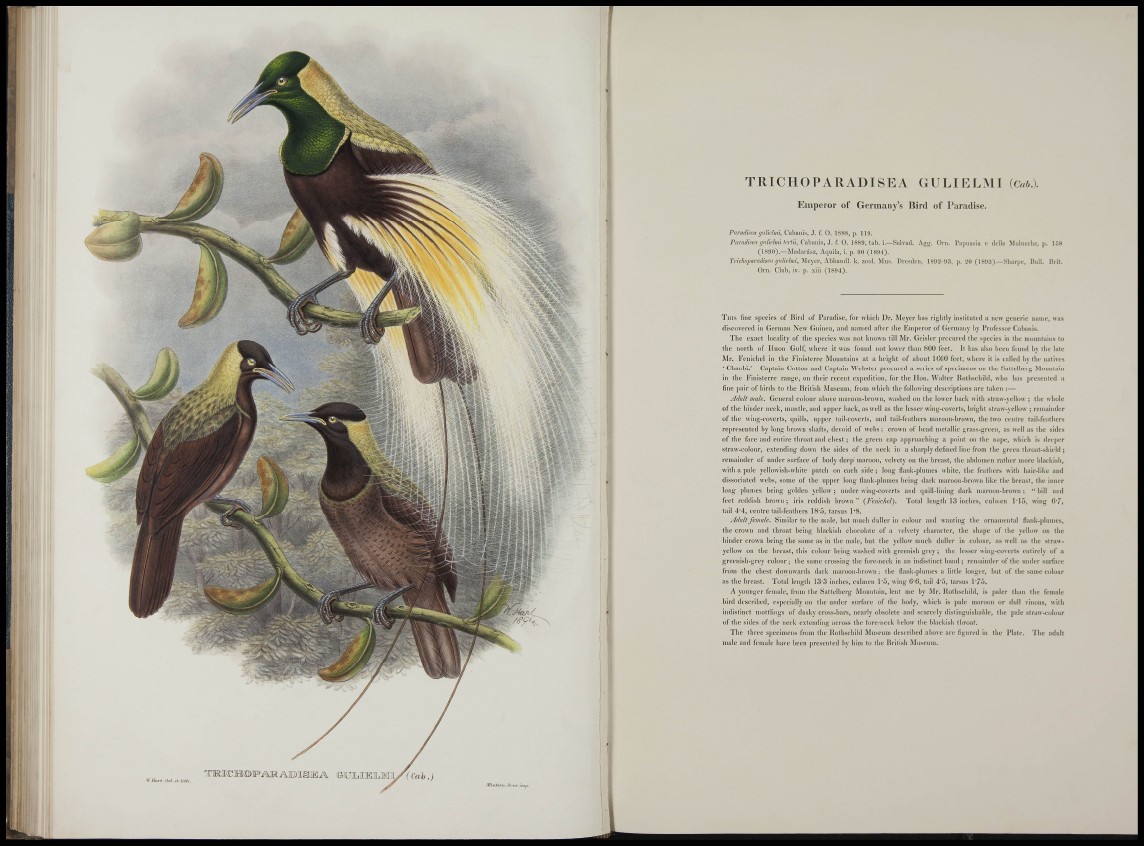
, : . I
Ih ii ri' • I 'P.
Plill
• r i i i i
H
m i
W llrn-t ,lel ct lUh . T l R J I C I H I i D T P i M i l A I D l S E i V GUJLHEMiyYCflfc.)
TRICHOPARADISEA GULIELMI (Caf>.).
Emperor of Germany's Bird of Paradise.
Paradisea (juKehm, Cabanis, J. f. O. 1S88, p. Ui).
Pm-fli/ism jii/iWmi fprtii, Cabanis, J. f. 0 . 1889, tab. i.—Salvaci. Agg. Orn. rapuasia t delle Moliicche, p. 158
(1890).—Madariisz, Aquila, i. p. !)0 (18S4).
Trichoparadism ffuliehni, Meyer, Ah\iand\. k.-¿ool. Mns. Dresden, 18<J2-!):i, p. 20 (18ii:)),—Sliarpe, Bull, lirlt.
Orn. Club, ii. p. xiii (1894).
Tiii.s fine species of Bird of Paradise, for which Dr. Meyer has rightly instituted a new generic name, was
discovered in German New Guinea, and named after tlie Emperor of Germany hy Professor Cabanis.
The exact locality of the species was not hnown till Mr. Geisler procured the sjiecies in the mountains to
the north of Huon Gulf, where it was found not lower than 800 feet. It has also been foimd by the late
Mr. Feniehcl in the Finisterre Mountains at a height of about ICOO feet, where it is called by tlie natives
• Chanbi.' Captain Cotton and Captain Webster jtrocured a series ofspeciineus ou the Sattelberg Mountain
in the Finisterre range, on their recent expedition, for the Hon. Walter liotbseliild, who has presented a
fine jiair of birds to the liritish Museuin, from which the following descriptions are taketi :—
Adult male. General colour above njaroon-brovvn, washed on the lower baek \vitb straw-yellow ; the whole
of the hinder neck, niautle, and up|)cr baek, as well as the lesser witig-coverts, bright straw-yellow ; remainder
of the wing-coverts, quills, upper tail-coverts, and tail-feathers maroon-browu, the two centre tail-feathers
rejiresented l)y long brown shafts, devoid of webs ; crown of bead metallic grass-green, as uell as the sides
of the face and entire throat and chest; the green cap aj)proacliing a ])oint on the najie, which is deeper
straw-colour, extending dowti the sides of the neck in a sharply defined line from the green throat-sliield ;
remainder of under surface of body deep maroon, velvety on the breast, the abdomen rather more blackish,
with a pale yellowish-white patch on each side ; long tlank-j)lnmes white, the feathers with hair-like and
dissociated webs, some of the upper long flank-plumes being dark maroou-brnwn like the breast, the iimer
long ])himes being golden yellow ; under wing-coverts and quill-lining dark maroon-brown : ** bill and
feet reddish brown; iris reddish browji " {Fenkltd). 'J'otal length 13 inches, cuiujen Mo, wing (J-7,
tail 4-4, centre tail-feathers 18'5, tarsus 1'8.
Adult female. Similar to the male, but much duller in colour and wanting the ornamental flank-[)lnmes,
the crown and throat being blackish chocolate of a velvety character, the shape of the yellow on the
hinder crown being the same as in the male, but the yellow much duller in colour, as well as the strawyellow
on the breast, this colour being washed with greenish grey ; the lesser ning-covcrts entirely of a
greenish-grey colour; the same crossing the fore-neck in an indistinct band; remainder of the under surface
from the chest downwards dark maroon-brown ; the flank-plumes a little longer, but of the same colour
as the breast. Total length 13"3 inches, culmen To, wing G'6, tail 4'5, tarsus lv5.
A younger female, from the Sattelberg Mountain, lent me by Mr. liotbseliild, is paler than the female
bird described, especially on the under surface of the bofly, which is ¡)ale maroon or dull vinous, with
indistinct niottliugs of dusky cross-bars, nearly obsolete and scarcely distinguishable, the pale straw-colour
of tlie sides of the neck extending across the fore-neck below the blackish throat.
The three specimens from the Rothschild Museum described above are figured in the Plate. The adtdt
male and female have been presented by him to the British Museum.
.yhnivrti iiiw, iiiiit.